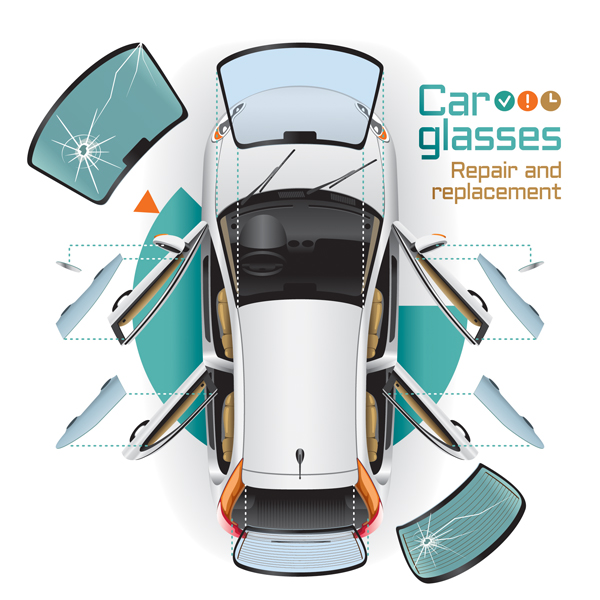WINDSCREEN & SIDE GLASS
Background information
The windscreen is an often neglected component of the vehicle. The windscreen is much more important than a mere screen between you and other road users. The safety needs stretch far beyond the obvious requirement of visibility for the driver! In today’s vehicles, windscreens are an important component of the vehicle’s overall structural integrity – they are designed to add strength to the car (like a door pillar). When designed in compliance with the car manufacturer’s original specifications your windscreen will help prevent the roof from collapsing in a rollover accident.
Modern cars fitted with airbags use the windscreen as a support surface against which the passenger airbag inflates. The windscreen helps ensure that the airbag is properly positioned to protect the occupants when it deploys. A badly fitted windscreen may pop out when subjected to the airbag pressure, thus rendering both airbag and windscreen useless.
While windscreen repair is less expensive than replacement, if you wait too long, and the damage has time to spread, windscreen repair will no longer be an option. Remember that just because a windscreen is chipped doesn’t mean that it needs to be totally replaced. Thirty per cent of the time a windscreen can be easily and effectively repaired before the damage worsens. The important thing is that, once a motorist notices a chip or a crack, it must be repaired as soon as possible, to prevent further damage that might impair visibility.

WINDSCREEN GLASS

SIDE GLASS
CALL +27 (0)21 556 2670
EMAIL : valerie@mckglass.co.za
Able to process 98% of insurance claims
100% Mobile
National coverage
Owner operated fitment centre
Cost Efficient
No single supplier Lock in
Centralized billing
Make A Quote
- drivers may take longer to re-adapt their vision following exposure to the stray light effects created through a worn windscreen (“dazzling”)
- detection distances to objects on the road ahead may be reduced when looking through worn windscreens
- the contrast of objects on the road ahead may be reduced – the consequence of which could be a reduction of visibility distances
- dirty windscreens seemed to cause drivers to crash twice as often in a driving simulator (as compared to driving with a new windscreen) and when driving with a degraded windscreen, drivers reaction times to a secondary task may be slowed.
- driving with a visually degraded windscreen induces fatigue and performance declines more rapidly than when driving with a non-degraded windscreen
- older drivers might find worn out windscreens to be even more debilitating compared with younger drivers
Safety is a very important issue. A faulty windscreen compromises the safety of you and your passengers – its ability to withstand an impact is substantially weakened. A damaged windscreen also inhibits your visibility and can be dangerous to you and other road users.
When light travels along a path without disturbance it is called “useful light”. However, the light path can be disturbed causing the beam to change in some way. The light that has been disturbed is referred to as “stray light”. The intensity of stray light depends on the scattering angle and the intensity of the original beam. This stray light can have a negative impact on driver perception.
Stray light can be generated in soiled or surface damaged windscreens. During the daylight the eye is adapted to stronger light with many different wavelengths; therefore the impact of stray light is not very severe at this time. However in the case of suddenly appearing light sources, such as oncoming headlights at night, the light that hits the windscreen can be deflected into the driver’s eye by means of wide angle light scattering, causing disturbances in vision and perception.
Different types of windscreen damage can result in different stray light effects. For example, small chips tend to scatter light with a halo around the light source, while scratches and grooves tend to scatter light perpendicularly to the damaged area and add one or two “tails” to the light source.
Every car will get a chip on its windscreen one or other time. In view of ongoing road works on almost all of South Africa’s major routes, the potential for windscreen chips and cracks is huge.
Damage to windscreens typically falls into two categories; sudden impact damage and degradation or wear.
Sudden impact damage includes cracks and “bullseyes”. Both this damage and degradation damage – through multiple fine scratches and chips resulting from gradual wear – may be distracting to drivers and cause visual problems
Windscreens are continuously bombarded by small particles such as tiny rocks, sand and dirt that wear the surface. Further to this, windscreen wipers can damage the windscreen over time by scratching tiny particles across the surface.
Scratching can occur when:
- the rubber has worn away and the windscreen is exposed to the bare metal of the wiper
- windscreen wipers are used on dry windscreens
- dirt is allowed to collect on windscreen wiper blades
Another factor that may compound the effects of windscreen degradation is soiling. It was suggested that grease and grime may result in the production of scattered light and further, that the removal of the grease and grime may result in the windscreen being scratched and damaged.
In South Africa the National Road Traffic Regulations, 1999 stipulate
[Glass of windscreen, window and partitions]
- (1) No person shall operate on a public road any motor vehicle having a windscreen, window or partition made of transparent material–
- unless such material affords the driver sufficient visibility for safe driving of such vehicle;
- unless in the case of a windscreen, other than a windscreen fitted to a motorcycle or motor tricycle, such transparent material–
is glass; and
ii. in respect of a motor vehicle which, according to the registration certificate thereof was registered for the first time after the year 1958, complies with the provisions of paragraph (a) even when shattered; and - unless, in respect of a motor vehicle which, according to the registration certificate thereof, was registered for the first time after the year 1958, such transparent material is safety glass and every pane thereof is permanently marked with the name or trademark of the manufacturer thereof or the trade name of the glass and is clearly identifiable as safety glass by a permanent mark indicating it as such.
(2) Notwithstanding the provisions of paragraphs (b) and (c) of sub-regulation (1), the transparent material– - with which–
a window in the roof of a motor vehicle;
ii. a window or partition of a bus or a mini-bus; or
iii. a window or partition of a semi-trailer designed or adapted for the conveyance of passengers,
is made, may consist of ultrahigh impact acrylic or polycarbonate plastic material where each pane thereof is permanently marked with the name or trademark of the manufacturer thereof or the trade name of the material and such material is clearly identifiable as ultrahigh impact acrylic or polycarbonate plastic material by a permanent mark describing it as such; - with which a window or partition or a removable or collapsible hood or canopy of a motor vehicle is made, may consist of a flexible plastic material; and
- with which a window or partition of a trailer, not designed or adapted for the conveyance of passengers, is made, may in the case where such trailer, according to the registration certificate thereof–
was registered for the first time before 1 January 1987, consist of acrylic or polycarbonate plastic material or of glass; or
ii. was registered for the first time on or after 1 January 1987, consist of acrylic or polycarbonate plastic material.
(3) No person shall operate on a public road any motor vehicle– - unless the visible light transmittance through–
the windscreen is at least 70 per cent; and
ii. any other window is at least 35 per cent,
when measured in accordance with paragraphs 6.3 of the standard specification SABS 1191 “Safety glass for windows”; - unless any film or tinting material applied to any windscreen, window or partition is free from bubbles, tears or scratches;
- if, after 1 January 2000, any film or material with a textured surface or any fixture or attachment is positioned over or applied to a windscreen or window in such a manner that its presence reduces visibility through such windscreen or window in any direction.
- Check that the windscreen is not cracked in the vision area – Do not drive with a seriously cracked windscreen – have it replaced as soon as possible.
- Check that the windscreen washers and wipers are working and that the wiper blades are in good condition.
- Before you leave the house on a cold winter morning, make sure to clear any frost from the windscreen with warm, not boiling, water. Boiling water may crack your windscreen.
- Drive with a clean windscreen – Depending on how dirty your windscreen is or what it has been contaminated with, there are a number of options. A windscreen or side glass that resists cleaning with ordinary soap and water probably has oil or grease on it. In this instance, you could use methylated spirits diluted 1:1 with water.
- Fix all chips, cracks and replace the windscreen if necessary.
- It is advisable to repair chips as soon as possible to prevent them from turning into cracks. Also, it is important to have chips repaired by a reputable fitment centre
- Check the effectiveness of your windscreen wipers – should they not be effective, do not hesitate to replace them.
- Check the water level in the windscreen wiper bottle. The windscreen will require a clean periodically when travelling a long distance to remove dirt from the windscreen.
A Perfect vision is important when travelling. It will not be a valid defence in court to say that you caused an accident because you could not see. If you can’t see – You may not drive!
